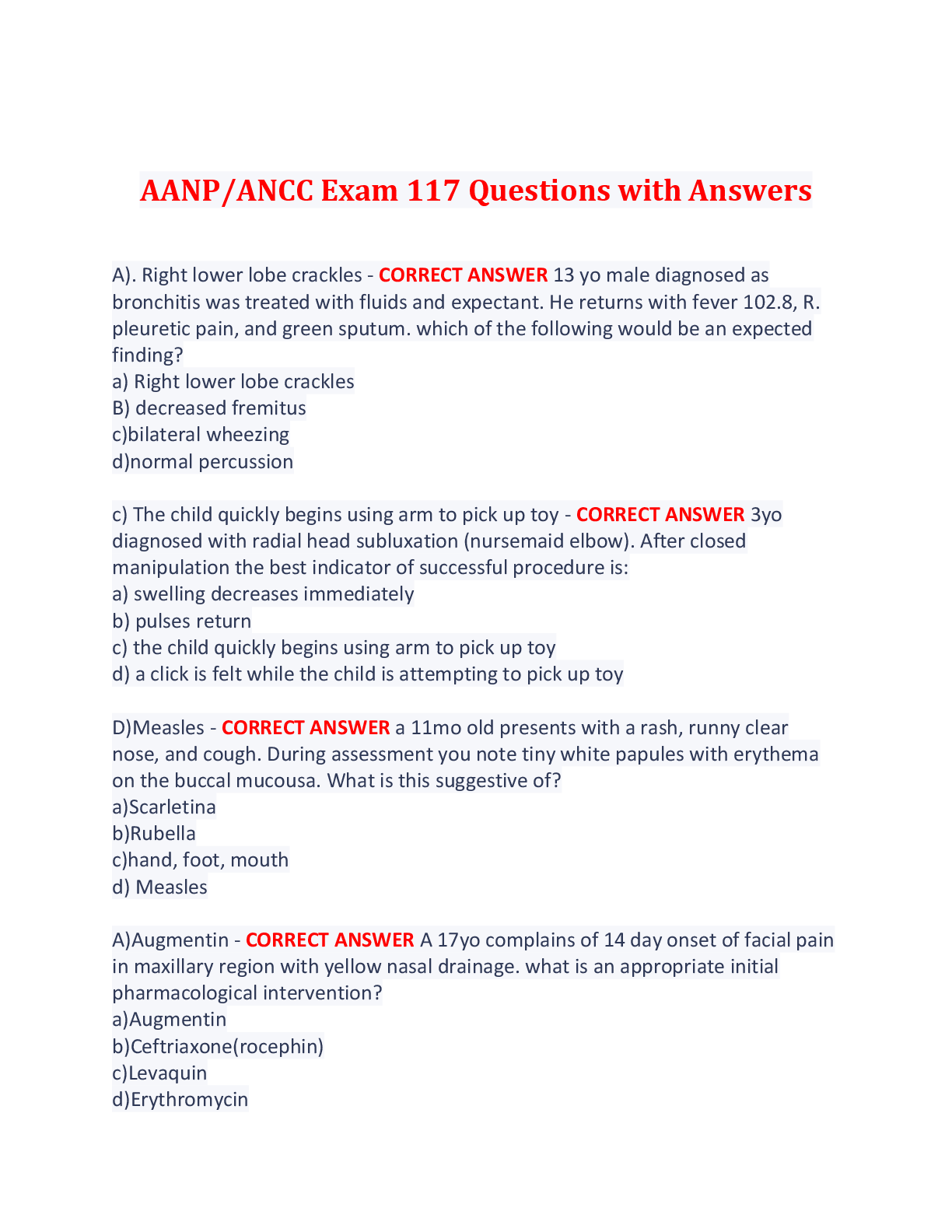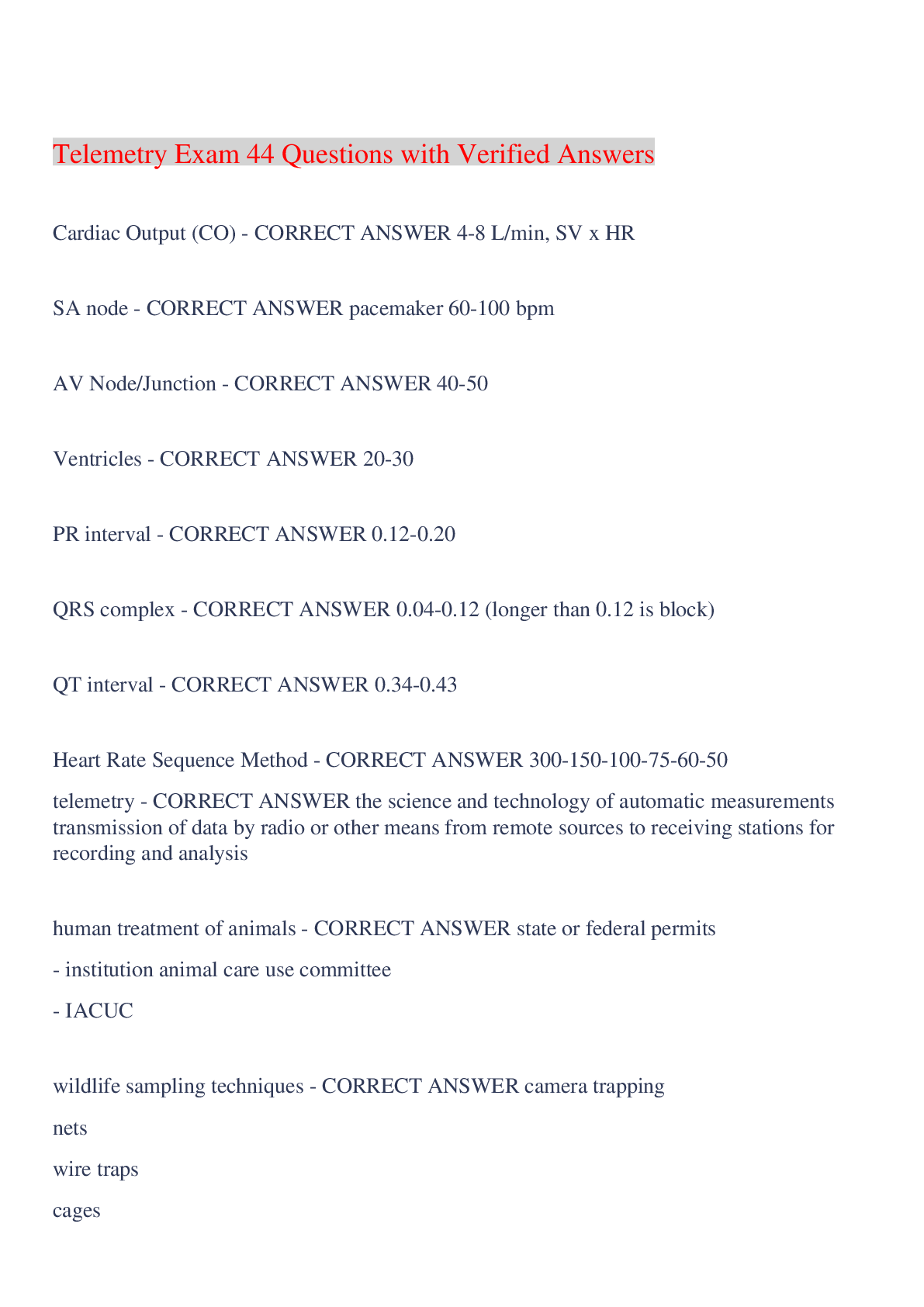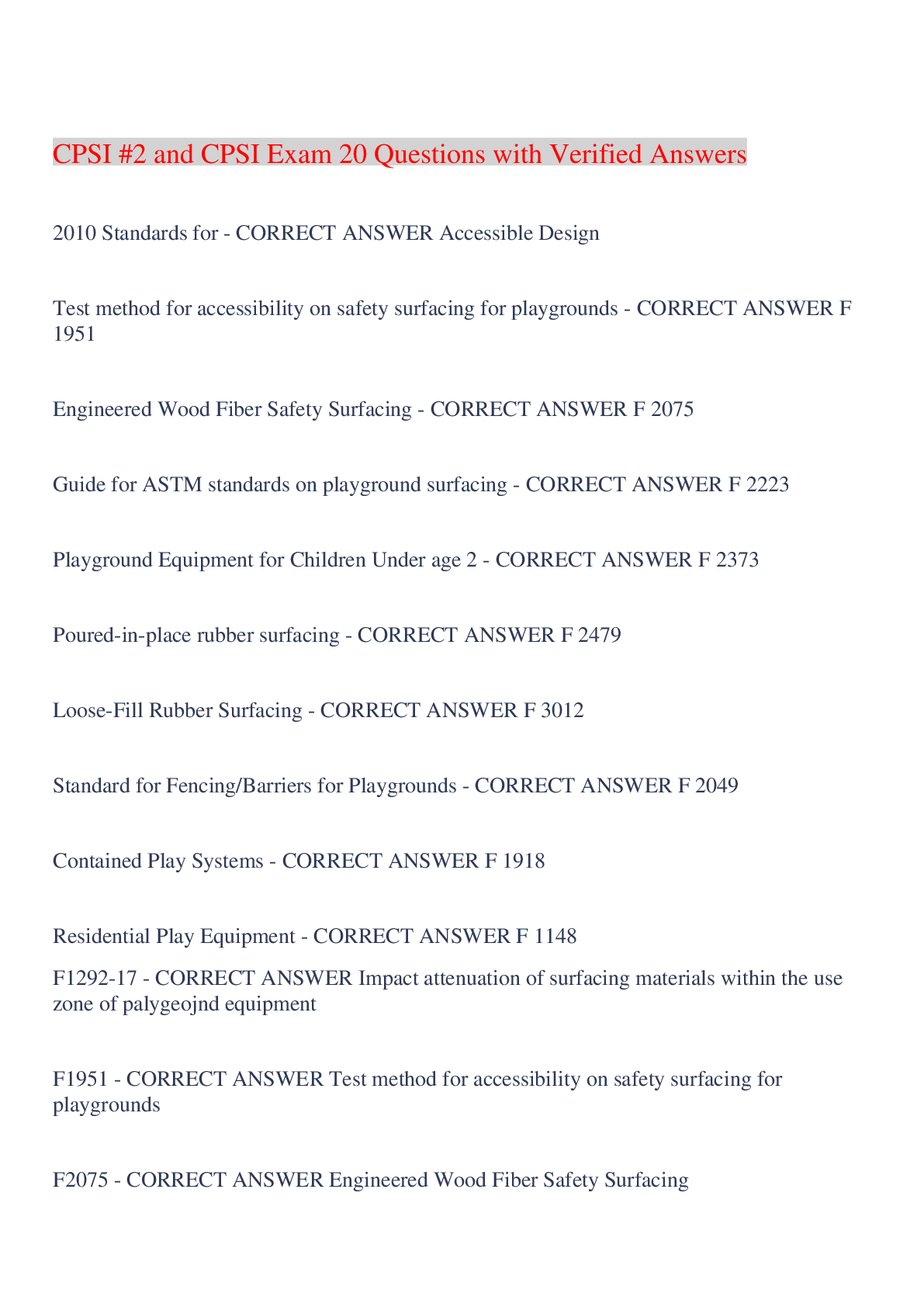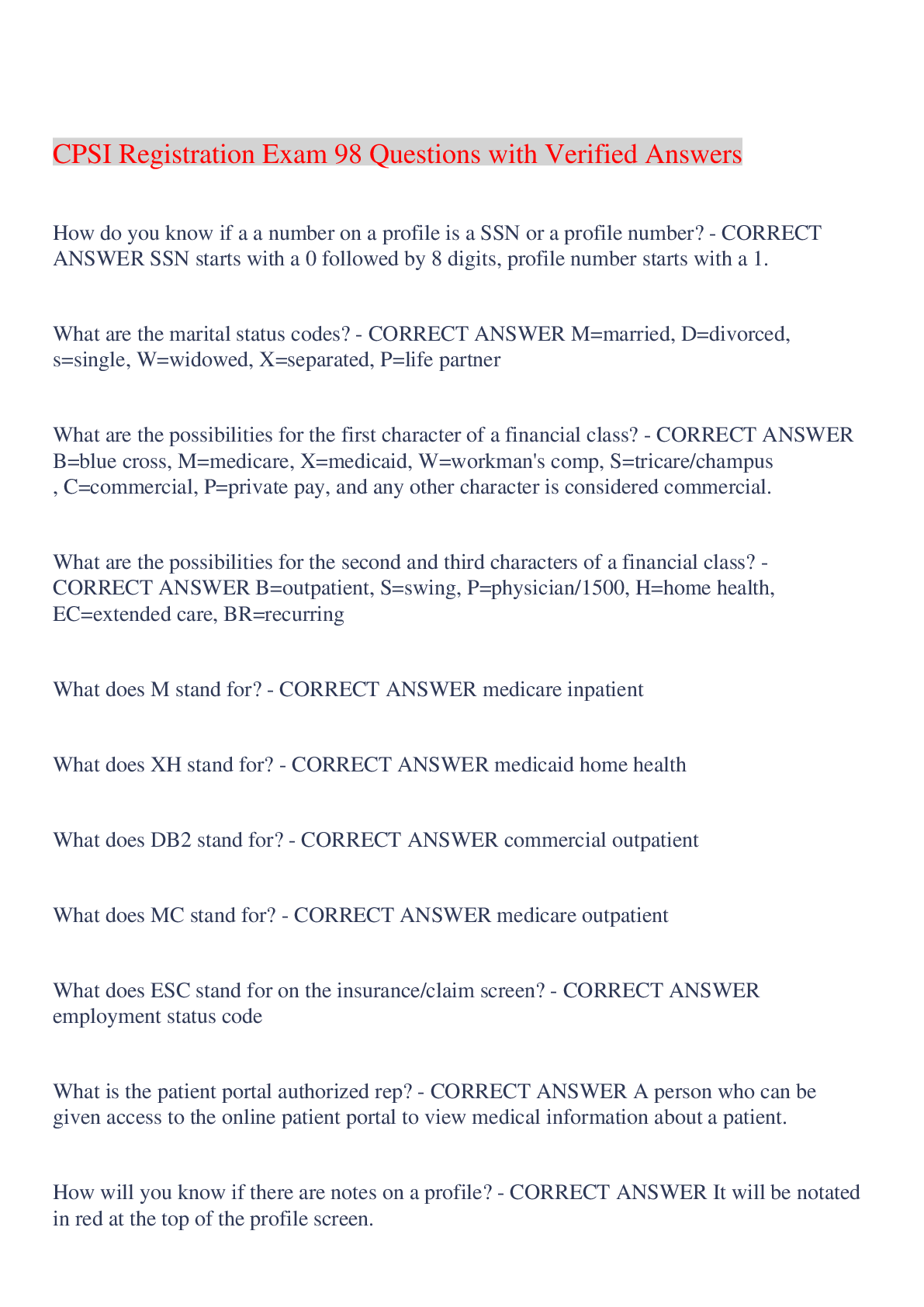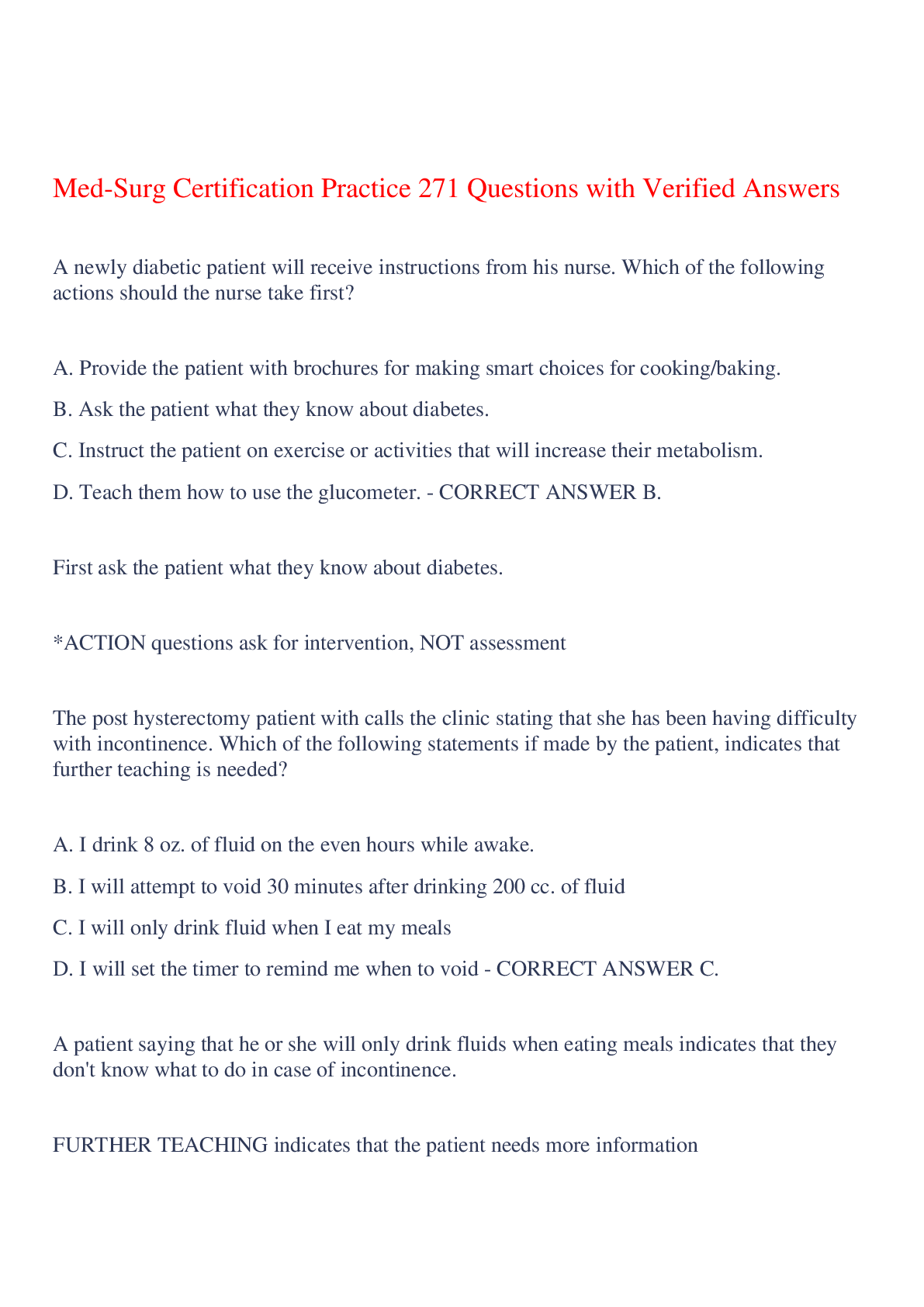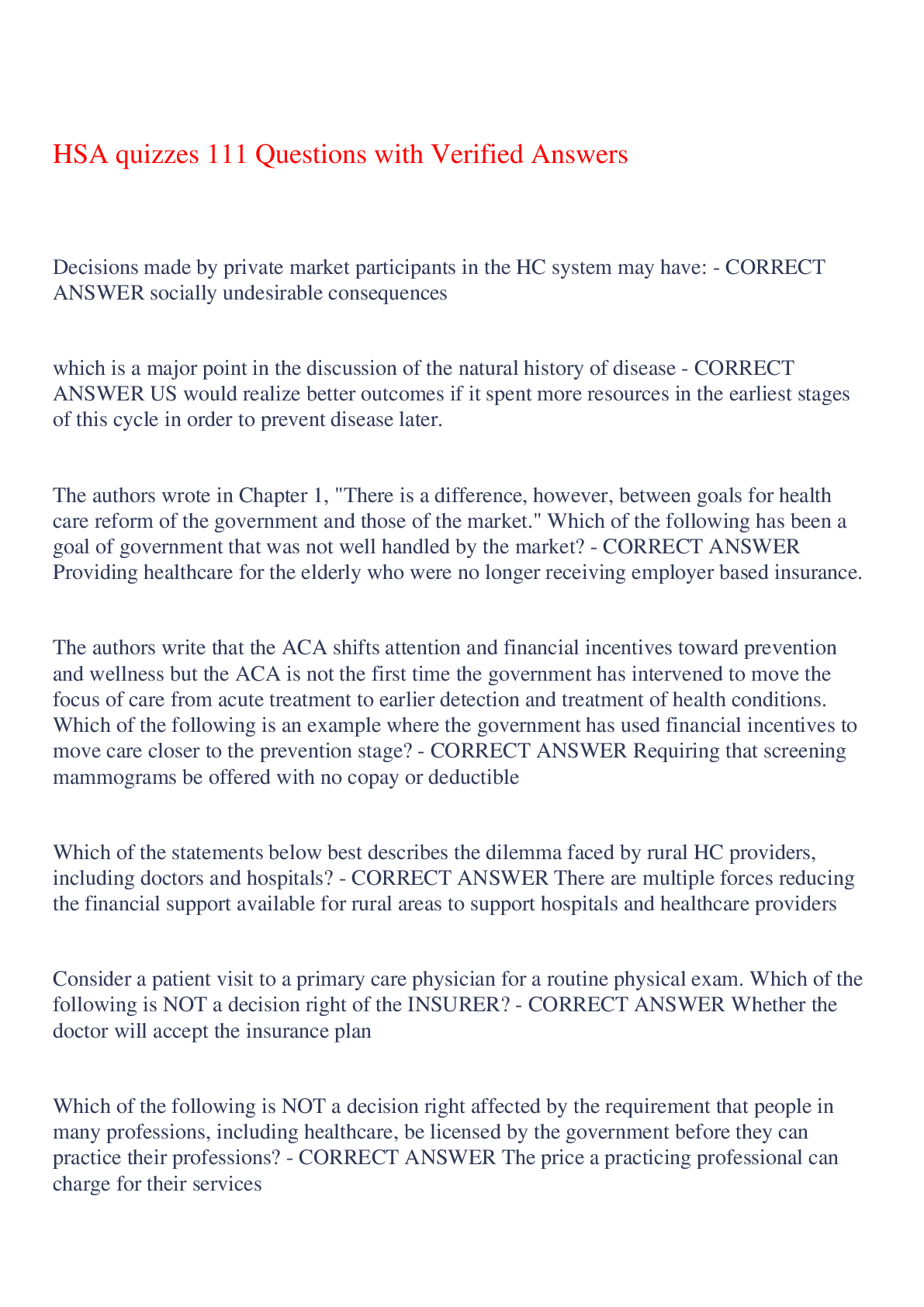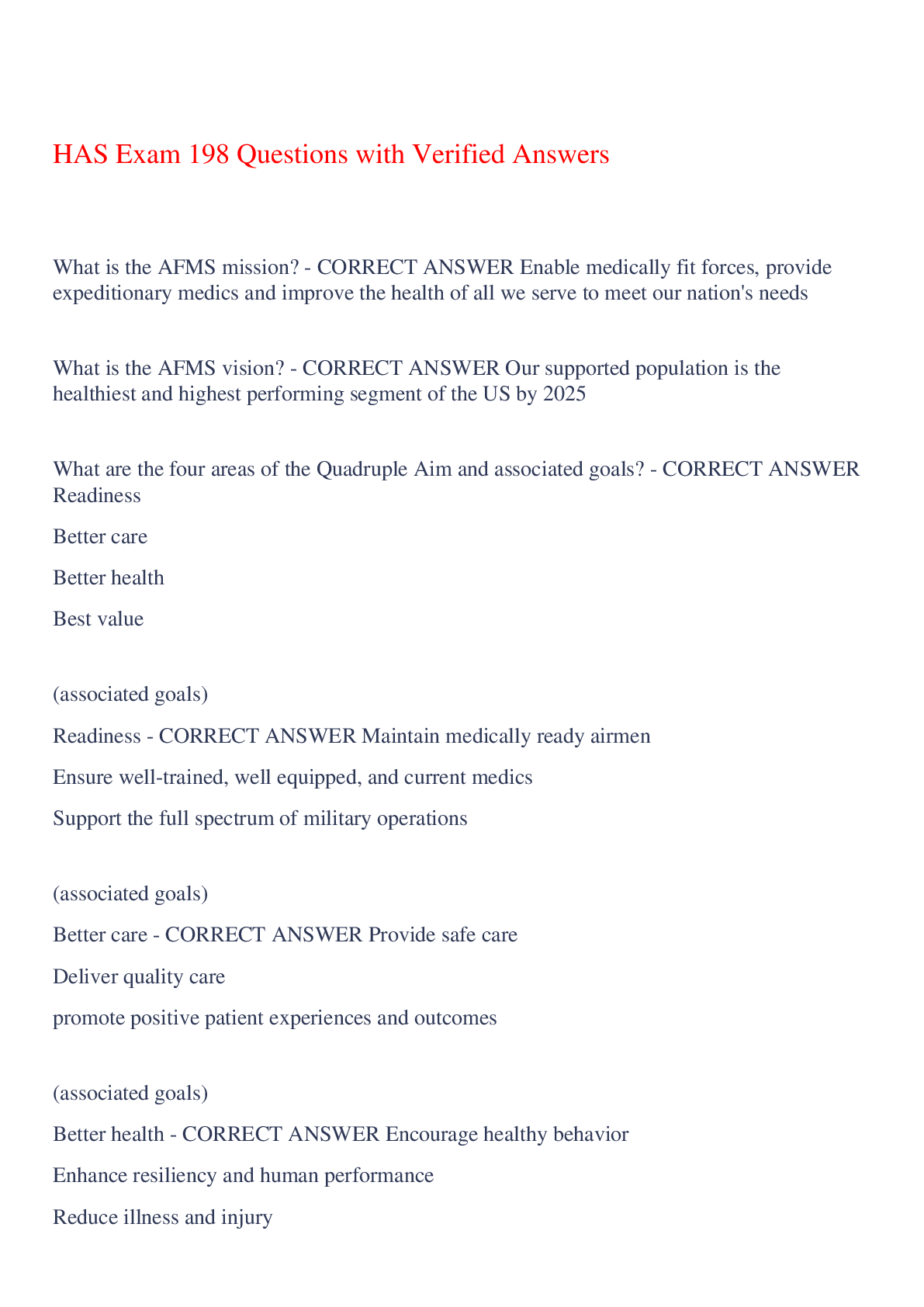*NURSING > EXAM > NURS 548 Patho final Unit 5: Respiratory system pathophysiology,100% CORRECT (All)
NURS 548 Patho final Unit 5: Respiratory system pathophysiology,100% CORRECT
Document Content and Description Below
NURS 548 Patho final Unit 5: Respiratory system pathophysiology Exercise 1: Respiratory tract infections, neoplasia and childhood disorders Rhinosinusitis (sinusitis) – which is not a char... acteristic of acute sinusitis - Infection or allergy obstructs sinus drainage - Acute: facial pain, headache, purulent nasal discharge, decreased sense of smell, fever - Chronic: nasal obstruction, fullness in the ears, postnasal drip, hoarseness, chronic cough, loss of taste and smell, unpleasant breath, headache Tuberculosis: Mycobacterium tuberculosis hominis: which is not a characteristic of mycobacterium tuberculosis hominis Tuberculosis: worlds foremost cause of death from a single infections agent, causes 26% of avoidable deaths in developing countries, drug resistant forms Mycobacterium TB hominis: - Aerobic - Protective waxy capsule (enhances resistance to acid fast bacillus - Can stay alive in suspended animation for years Milary TB: Know the flow chart Rare, the organisms erode the blood vessels -> hematogenuous spread (spreads in vascular system) -> brain, meninges, liver, kidney, bone marrow - Milary Tb lesions look like grains of millet in the tissues - Meat inspection was introduced to keep them out of the food supply - Pasteurization of milk was introduced to keep Tb out of the milk supply Progessive primary TB: - Signs of pneumonia - Bacteria in sputum and exhaled droplets - Bacteria may erode BV and spread through the body – milary TB Neonatal respiratory distress syndrome: incorrect statement - Lack of surfactant: infants are not strong enough to inflate their alveoli - Protein rich fluid leaks into the alveoli and further blocks oxygen uptake - Treatment with mechanical ventilation and lead to bronchopulmonary dysplasia and chronic respiratory insufficiency Exercise 2: Disorders of ventilation and gas exchange Know the definition of atelectasis Atelectasis: the incomplete expansion of the lung or a portion of the lung Pneumothorax: incorrect statement - Air enters the plural cavity - Air takes up space, restricting lung expansion - Partial or complete collapse of the affect lung A. Spontaneous: an air filled blister on the lung ruptures B. Traumatic: air enters through chest injures 1. Open: air enters pleural cavity through the wound on inhalation and leaves through exhalation 2. Tension: air enters pleural cavity through the wound on inhalation but cannot leave on exhalation Intrinsic (nonatopic) asthma: know the causes of nonatopic asthma episodes are triggered by: - Respiratory infections: epithelial damage, IGE production - Exercise, hyperventilation, cold air: loss of heat and water may cause bronchospasm - Inhaled irritants: inflammation, vagal reflex - Aspirin and other NSAIDS: abnormal arachidonic acid metabolism - Hormonal changes, airborne pollutants, GERD emotional upset Initiated by non-immune mechanism Chronic Obstructive Pulmonary Disorders: know characteristics of bronchiectasis: Chronic and recurrent obstruction of airflow in pulmonary airways – progressive 2 types: emphysema and chronic obstructive bronchitis Emphysema: - Enlargement of air spaces and destruction of lung tissue - Loss of lung elasticity, enlargement of air spaces (distal to terminal bronchioles), destruction of alveolar walls and capillary beds Chronic obstructive bronchitis: - Obstruction of small airways Bronchiectasis: - Infection and inflammation destroy smooth muscles in airways, causing permeant dilatation - Obstruction of major and small airways - Marked increase in goblet cells with excess mucus -> plugs airway lumen, inflammatory infiltration, and fibrosis of bronchiolar wall Pink puffer’s vs blue bloaters: Chronic bronchitis incorrect manifestation Pink puffers (usually emphysema): - Increase respiration to maintain oxygen levels - Dyspnea, increased ventilatory effort - Use accessary muscles: purse lip breathing Blue Bloaters (usually bronchitis - Cannot increase respiration enough to maintain oxygen - Cyanosis and polycythemia - Cor pulmonale : Right sided heart failure resulting from primary lung disease and long standing primary or secondary pulmonary HTN Hypercapnia: which is not seen in hypercapnia - PCO2 > 50 mm hg - Respiratory acidosis a. Increased respiration b. Decreased nerve firing 1. Carbon dioxide narcosis – sedative effect on nervous system 2. Disorientation, somnolence, coma c. Decreased muscular contraction 1. Vasodilatation: head ache, conjunctival hyperemia, warm flushed skin 2. Dilating effect of many blood vessels Increased C02 content in arterial blood Co2 cross blood brain barrier and stimulates the respiratory center of the brain located in brain stem for 1-2 days. Compensatory mechanism of the kidney then readjusts the blood PH (respiratory center declines) Unit 6: urinary system pathophysiology Exercise 1: disorders of renal function Urinary tract infections in special populations: incorrect statement: Women: - UTI’s are more common in women than in men, with peak incidence in the 15-24 old age group - Pregnant women are at increased risk for UTIS Children: - UTIS are common in young children - UTIS in children often involve pyelonephritis Elderly: - UTIS are relatively common in the elderly - 2nd most common form of infection, after respiratory infections, among healthy community dwelling elderly Disorders of Glomerular Function: Know nephrotic syndrome Nephritic syndrome: proliferative inflammatory response Nephrotic syndrome: - Caused by disorders that increase permeability of the glomerular membrane, causing massive loss of protein in the urine - Mixed nephritic and nephrotic responses - Chronic glomerulonephritis: inflammation of the glomerular - Glomerular lesions associated with systemic disease Exercise 2: renal failure Types of acute renal failure: know all 3 types Prerenal: - Decrease blood supply - Shock, dehydration, vasoconstriction Post renal: - Urine flow is blocked- disorders that interfere with the elimination of urine - Stones, tumors, enlarge prostate Intrinsic: - Kidney tubule function is decreased – disorders that disrupt the structures in the kidney - Ischemia, toxins, intratubular obstruction Clinical manifestations of chronic renal failure: know flow chart – which is not a manifestation of CRF Cardiovascular consequences of chronic renal failure: which is not a cardiovascular consequence of CRF - Decreased blood viscosity - Increased blood pressure - Decreased oxygen supply Chart: less erythropoietin -> anemia -> lower blood viscosity -> blood flows through vessels more swiftly -> heart rate increases -> increased workload on left heart -> left ventricle dilation and hypertrophy -> not enough o2 to support LV contraction -> angina, ischemia, left heart failure Exercise 3: disorders of urine elimination Neurogenic bladder disorders: know flaccid bladder 1. Spastic bladder: failure to store urine - Often causes by spinal cord injury - Uninhibited neurogenic bladder may develop after a stroke 2. Flaccid Bladder: failure to empty urine - May occur because of injury to the micturition center of sacral cord, cauda equine, or sacral spinal nerves - Peripheral neuropathies ( a complication of diabetes mellitus) my lead to flaccid bladder - Detrusor muscle areflexia: flaccid neurogenic bladder - Atony of detrusor muscle and loss of perception relaxed to bladder fullness-> overstretching of detrusor muscle-> weak and ineffective bladder contractions - Decrease external sphincter tone and decreased perineal muscle tone - Voluntary urination will not occur - Increase abdominal pressure or manual suprapubic pressure maybe utilized to achieve efficient emptying 3. Non-relaxing external sphincter - May result from anxiety or depression Urinary incontinence: know over flow incontinence 1. Stress incontinence - Associated with activities that increase intra-abdominal pressure such as coughing, laughing, sneezing or lifting 2. Urge incontinence/ overactive bladder - Associated with hyperactivity of the detrusor muscle 3. Overflow incontinence - Occurs when intravascular pressure exceeds the maximal urethral pressure - In men, one of the most common causes of prostate enlargement - bladder distention occurs in absence of detrusor activity - may occur with retention of urine 2nd to nervous system lesions or obstruction of bladder neck - causes: prostate enlargement, fecal impaction - with this type of incontinence the bladder is distended and small amounts of urine pass (more at night) 4. Other causes of incontinence - Decrease bladder distend ability resulting from radiation therapy, radical pelvic surgery or interstitial cystitis Unit 7: digestive system pathophysiology Exercise 1: disorders of gastrointestinal function Inflammation and damage to the bowel wall can lead to: know the slide - Hemorrhage -> anemia - Perforation -> peritonitis - Decrease mucosal function -> malabsorption - Decreased bacterial containment -> sepsis Inflammation of the small and large intestines: know characteristics of crohns - Irritable bowel syndrome - Inflammatory bowel disease 1. Crohns 2. Ulcerative colitis - Infectious enterocolitis 1. Viral infections 2. Bacterial infections - Diverticular disease - Appendicitis Know characteristics of crohns disease Infectious enterocolitis: know the characteristics The bowel attempts to get rid of the infectious agent - Exudate to dilute toxins - Hypermobility A. Vomiting Decreased intestinal function - Food not absorbed A. Osmosis draws water into the bowel B. Osmotic (or explosive diarrhea) Intestinal obstruction: know mechanical obstruction Mechanical obstruction: - Severe, colicky pain - Borboygmus - Audible, high pitched peristalsis, peristatic rushes - Awareness of intestinal movements Paralytic obstruction - Continuous pain - Silent abdomen Alterations in intestinal absorption: be able to define celiac disease Malabsorption syndrome - May affect absorption of one nutrient or of many Celiac disease (celiac sprue) - Immune-mediated disorder triggered by ingestion of gluten containing grains Intestinal neoplasms: know adenomatous polyps Adenomatous Polyps - Most common neoplasm of the intestine - Benign neoplasms arising from the intestinal epithelium - Most cases of colorectal cancer begin and adenomatous colonic polyps Colorectal cancer: - 3rd most common cancer in men and women - 2nd leading cause of cancer death - Incidence of colon cancer increases with age - Diet is thought to play a role in the incidence of colorectal cancer A. A high fiber diet is felt to be protective for colorectal cancer Exercise 2: disorders of hepatobiliary and pancreas function Metabolic functions of the liver: question will be which is not a function of liver Carbohydrate, protein and lipid metabolism - sugars -> stored as glycogen, converted to glucose used to make fats - proteins -> synthesized from amino acids; ammonia made into urea - fats -> oxidized for energy, synthesized, packed into lipoproteins - drug and hormone metabolism A. biotransformation into water-soluble forms B. detoxification or inactivation - bile production - bilirubin elimination detoxifies the blood by removing or altering drugs and hormones (thyroid and estrogen) removes water waste product bilirubin stores fat soluble vitamins A,B12,D,E,K stores iron and copper phagocytizes worn out blood cells and bacteria activate vitamin D (the skin can also do with 1 hour of sunlight a week) Jaundice: know the chart pre hepatic causes of jaundice - yellowish discoloration of skin an deep tissue - sclera of the eye is usually one of the first structures in which jaundice can be detected - results from an abnormal accumulation of bilirubin in the blood Pre hepatic causes of jaundice - hemolytic blood transfusion reaction - hereditary disorders of the red blood cell 1. sickle cell anemia 2. thalassemia 3. spherocytosis - acquired hemolytic disorders - hemolytic disease of newborn - autoimmune hemolytic anemias Chronic Viral Hepatitis: know subtypes - caused by HBV, HCV, and HDV – HAV is not chronic - principal cause of chronic liver disease, cirrhosis, and hepatocellular cancer in the world - chief reason for liver transplantation in adults hepatitis: inflammation of the liver Hepatitis A: HAV - cause is RNA containing HAV - benign self-limiting disease, brief incubation (15-45 days) - transmitted fecal oral route, replicates in liver, excrete in the bile, shed in stool - common routes of transmission -> drinking contaminated milk, water, eating shellfish from infected waters - onset abrupt symptoms: fever, malaise, nausea, anorexia, abdominal discomfort, dark urine, jaundice - duration -> 2 months does not cause chronic hepatitis or induce a carrier state Hepatitis B: HBV - caused double stranded DNA virus (HBV_ common virion referred to as the dane particle (outer envelope and inner nucleocapsid containing HBV DNA and DNA polymerase - incubation period 4-6 weeks. Presence of viral DNA (HBV DNA) in blood indicates active infection - transmission : usually inoculation via infected blood or serum may be spread by oral or sexual contact (viral antigen found most body secretions) - high prevalence amongst iv drug abusers multiple sex partners and homosexuals Manifestations - acute symptoms, chronic hepatitis progression to cirrhosis, fulminant hepatitis with massive hepatic necrosis, carrier state - participates in development of hepatitis D - infants who become infected (born to infected mother) 90% risk of becoming chronic carriers. Up to 25% will die of liver disease as adults hepatitis C: HCV - cause single stranded RNA virus (HCV) - distantly related to viruses that cause yellow fever and dengue fever - most common cause of chronic hepatitis, cirrhosis and hepatocellular cancer in world - most are unaware until symptoms present. These people serve as source of infection to others - transmission: small amounts of blood via tattooing, body piercing, acupuncture, sexual contact, iv drug abuse(major source), possibly mother to infant - incubation 2-26 weeks - mild symptoms: fatigue, malaise, anorexia weight loss - hepatic failure is rare Hepatitis D: HDV - cause delta hepatitis agent - a defective RNA virus - infection occurs concomitantly with hep B increased severity of hep B infection - transmission same as hep B - 2 forms: super infection imposed on chronic hep B or carrier state & along with acute Hep B infection Alcoholic liver disease: know fatty liver Fatty liver (steatosis) - liver cells contain fat deposits, liver is enlarge alcoholic hepatitis - liver inflammation and liver cell failure cirrhosis - scar tissue partially blocks sinusoids and bile canaliculi Portal hypertension: which is not a consequence of portal hypertension Increased pressure in peritoneal capillaries - ascites Portosystemic shunting of blood - development of collateral channels 1. caput meduase 2. hemorrhoids 3. esophageal varices - shunting of ammonia and toxins from the intestine into general circulation 1. hepatic encephalopathy Splenomegaly 1. anemia 2. thrombocytopenia 3. leukopenia Venous blood from the Gi tract empties into the portal veins and travels through the liver for cleansing The blood then enters the inferior vena cava Liver failure leads to: know the consequences of liver failure Hematologic disorders: - anemia, thrombocytopenia, coagulation defects, leukopenia Endocrine disorders: - fluid retention, hypokalemia, disordered sexual functions - which hormones would cause these endocrine disorders? Skin disorders: - jaundice, red palms, spider nevi hepatorenal syndrome - azotemia, increased plasma creatinine, oliguria hepatic encephalopathy - asterixis, confusion, coma, convulsions disorders of the gallbladder cholelithiasis (gallstones) - cholesterol, calcium salts or mixed acute and chronic cholecystitis - inflammation caused by irritation due to concentrated bile choledocholithiasis - stones in the common bile duct - common duct stones usually originate in gallbladder but may also form in the duct - stones can also obstruct outflow of pancreatic duct (pancreatitis) cholangitis - inflammation of the common bile duct cancer of the gallbladder pancreatic cancer: know which statement is incorrect - 4th leading cause of cancer death in US - Smoking is major risk factor for pancreatic cancer - Most cancer of the pancreas has metastasized at time of diagnosis - Pain management is one of the most important aspects of management Unit 8: endocrine system pathophysiology Exercise 1: disorders of endocrine function Hormone disorders: know the slide Tertiary: abnormality in stimulation from the hypothalamus (dysfunction) Secondary: abnormality in stimulation from the pituitary – normal gland its function is altered by defective levels of stimulating hormone or releasing factors from the pituitary Primary: abnormality in the gland – involve a defect in endocrine function originating in the gland itself Functions of growth hormone: know the functions Growth promoting actions -> IGF-1 -> increased protein synthesis 1. Bone and cartilage -> increase linear growth 2. Body organs -> increased size and function 3. Muscles-> increased lean muscle mass Anti-insulin effects 1. Adipose tissue-> increase lipolysis, increased FFA use -> decrease in adiposity 2. Carbohydrate metabolism -> decreased glucose use -> increase blood glucose Thyroid Imbalances: know Hashimotos thyroiditis Hypothyroidism: - Congenital - Acquired: 1. Hashimotos thyroid -most common cause of hypothyroidism - autoimmune disorder- predominately women - although disorder is usually reflective of hypothyroidism, a hyperthyroid can develop in mid course of disease due to leakage of preformed hormone from damaged cells 2. Thyroidectomy - Hyperthyroidism (thyrotoxicosis) 1. graves disease 2. Thyroid tumors Actions of cortisol: know actions of cortisol 1. Plasma proteins increased 2. Immune/inflammatory system suppressed Cabalism increased - Muscle breakdown - Free fatty acids increased - SNS response increased - Blood glucose increased Exercise 2: diabetes mellitus Endocrine pancreas: islets of langerhands: 1. Alpha cells -> glucagon 2. Beta cells -> insulin and amylin 3. Delta cells -> somatostatin 4. PP cells: pancreatic polypeptide Types of diabetes mellitus Type 1: pancreatic beta cell destruction predominately by an autoimmune process Type 2: a combination of beta cell dysfunction and insulin resistance Other: - Genetic defects in insulin production - Genetic defects in insulin action - Diabetes secondary to other disease - Drug interactions Gestational diabetes mellitus Pathogenesis of type 2 diabetes: know the pathogenesis of type 2 - Impaired insulin secretion - Increased basal hepatic glucose production - Carbohydrate absorption - Decreased insulin stimulated glucose uptake Chronic complications of diabetes mellitus: know chronic complications Increased glucose level allows glucose to bind in proteins in: - Hemoglobin -> HB A1C has higher 02 affinity - Basement membranes of blood vessels 1. Nephropathy 2. Retinopathy 3. May cause increased risk of atherosclerosis 4. Lens -> cataracts Increased vulnerability of infections Diabetic neuropathy: know autonomic neuropathy Somatic neuropathy: - Diminished perception of vibration, pain and temperature - Hypersensitivity to light touch, occasionally severe burning pain Autonomic neuropathy: - Defects in vasomotor and cardiac responses - Impaired motility of gastrointestinal tract - Inability to empty bladder - Sexual dysfunction Unit 9: neuromuscular and neurological pathophysiology Exercise 1: disorders of neuromuscular function Upper neuron damage: know consequences: - Weakness and loss of voluntary motion - Spinal reflexes remain intact but cannot be modulated by the brain 1. Increased muscle tone 2. Hyperreflexia 3. Spasicity Myasthenia gravis: incorrect statement Autoimmune disease - Gradual destruction of acetylcholine receptors - Associate with thymus tumor or hyperplasia Gradual development of weakness - from proximal to distal portions of body myasthenia crisis: respiratory compromised Basal ganglia dysfunction can increased patterned movement: know hyperkinesia terminology Tremors Tics Hyperkinesia: - choriform: jerky movements - athetoid: continues twisting movements - ballismus: violent flinging movements - dystonia: rigidity Parkinson’s disease: know signs and symptoms - tremor - rigidity - bradykinesia (slow movement) - loss of postural reflexes - autonomic system dysfunction - dementia Amyotrophic lateral sclerosis: know slide - damages both upper and lower motor neurons - UMN damage- > weakness, lack of motor control 1. Loss of control over spinal reflexes -> stiffness, spasticity - LMN damage 1. Irritation -> Fasciculation 2. Decrease neuron firing -> weakness, denervation, atrophy, hyporeflexia Partial spinal cord injury: be able to identify the 3 syndromes Central cord syndrome: damage to axons near the gray matter - Arms more affected than legs Anterior cord syndrome: damage to anterior section of cord - Motor functions affected, touch sensation not affected Brown-sequard syndrome: damage to one side of the cord - Motor function lost on that side, pain/temperature sensation lost from other side Exercise 2: disorders of brain function Intracranial pressure (ICP): which is not a cause of ICP Compartment syndrome in the skull - Intracranial pressure greater than arterial blood pressure - Arteries collapse, blood flow to brain cut off Brain swelling: - Vasogenic extracellular fluid - Cytotoxic intracellular fluid Hydrocephalus: cerebrospinal fluid Tumors Traumatic brain injury: Primary injuries: due to impact - Microscopic damage: concussion, diffuse axonal injury - Contusions Secondary injuries due to: - Hemorrhage - Ischemia - Infection - Increased intracranial pressure Hematoma: broken blood vessels: identify types of hematoma Epidural space: meningeal arteries Rapid bleeding: unconsciousness may be followed by brief lucid period Dura mater: - Subdural space: bridging veins - Slower bleeding gradual development over days or weeks Epidural hematoma: Subdural hematoma: Intracerebral hematoma: Brain infections: know meningitis Meningitis: 1. Bacterial meningitis - Fever chills, head ache, stiff neck and back, abdominal and extremity pains, nausea and vomiting - Caused by streptococcus pneumoniae, haemophilus influenza, or Neisseria meningitis 2. Viral meningitis - Less severe course than bacterial meningitis - Usually caused by coxsackie D and echovirus Encephalitis: - Usually caused by virus but maybe caused by bacteria, fungal, and other organisms Kinds of seizures: identify type of seizure Absence (petit mal) disturbances in consciousness Atonic loss of muscle tone Myoclonic muscles contract Tonic- clonic (grand mal) muscle contraction and loss of consciousness Generalized convulsive status epilepticus: seizures continue without recovery between them Many dementias are associated with abnormal inclusions in the brain: will need to identify one disease Alzheimer disease: amyloid plaques Pick disease: pick bodies Prion diseases: prion proteins - Creutzfeldt-Jakob disease [Show More]
Last updated: 2 years ago
Preview 1 out of 21 pages

Buy this document to get the full access instantly
Instant Download Access after purchase
Buy NowInstant download
We Accept:

Reviews( 0 )
$16.00
Can't find what you want? Try our AI powered Search
Document information
Connected school, study & course
About the document
Uploaded On
Sep 21, 2022
Number of pages
21
Written in
Additional information
This document has been written for:
Uploaded
Sep 21, 2022
Downloads
0
Views
45


